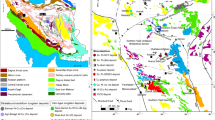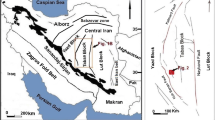Summary
A widespread feature of Variscan siderite-Pb-Zn-Cu vein deposits in the Rheinisches Schiefergebirge, Germany, is an overprinting brought about by late-Variscan Sb-rich fluids which exploited the existing vein geometry. In a number of cases, this later event led to considerable textural modification of the primary sulphide assemblage. Sphalerite is a major component of the primary mineralization in the Stahlberg (Müsen), Schöne Freundschaft (Obersdorf) and Silberwiese (Oberlahr) deposits, Siegerland-Wied district and the Silbersand (Mayen) and Saarsegen (Altenahr) deposits in the Eastern Eifel. Primary sphalerite (sphalerite 1) displays corrosion, replacement by a range of Pb-Sbsulphosalts, partial dissolution and, ultimately, remobilization as a result of the overprinting event. Remobilized sphalerite has recrystallized (Sphalerite II) directly from the overprinting fluid. A comparable textural evolution is also noted in samples from the Dörnberg-Aurora (Ramsbeck) mine, although, in this case, several distinct stages of textural modification and remobilization are recognised, resulting from a yet more complex sequence of vein emplacement.
Microanalysis of sphalerite representing distinct stages of textural evolution in each of the deposits reveals extensive removal of Fe by diffusion ahead of the reactive replacement front. Second generation sphalerite contains only low contents of Fe. The data are consistent with theoretical predictions and experimental observations of interdiffusion of Fe and Zn in sphalerite in contact with a low Fe/Zn fluid. Interaction with the Sb-rich fluids was sufficiently prolonged to permit substantial textural and compositional modification of the primary sphalerite, particularly in the case of smaller grains close to the reaction front. However, relatively rapid cooling resulted in a cessation of interdiffusion before equilibrium between fluid and solid could be established.
Zusammenfassung
Innerhalb zahlreicher varistischer Siderit-Pb-Zn-Cu-Ganglagerstätten des Rheinischen Schiefergebirges erfolgte eine hydrothermale überprägung durch spätvaristische Sb-reiche Fluide, die entlang der präexistenten tektonischen Elemente der Gänge bevorzugte Wegsamkeiten fanden. In einigen Fällen führte dieses spätere Hydrothermalereignis zu einer bedeutenden Veränderung der Gefüge der primären Sulfidmineralisation. In den Lagerstätten Stahlberg (Müsen), Schöne Freundschaft (Obersdorf) und Silberwiese (Oberlahr) im Siegerland-Wied-Distrikt und Silbersand (Mayen) und Saarsegen (Altenahr) in der östlichen Eifel stellt Sphalerit eine Hauptkomponente der primären Mineralisation dar. Die Gefüge des primären Sphalerit (Sphalerit I) zeigen eine sukzessive Entwicklung, die von Korrosion und partieller Verdrängung durch verschiedene Pb-Sb-Sulfosalze über intensive Wiederauflösung schließlich zu vollständiger Remobilisation führt. Remobilisierter Sphalerit wurde teilweise wieder als jüngere Generation (Sphalerit II) abgeschieden. Eine vergleichbare Gefügeentwicklung liegt in Proben der Dörnberg-Aurora-Lagerstätte (Ramsbeck) vor, obwohl hier verschiedene überprägungsstadien und wiederholte Remobilisationen von Sphalerit während einer komplexeren tektonischen und hydrothermalen Entwicklung erfolgten.
Mikrosondenanalysen von Sphalerit aus verschiedenen texturellen Stadien zunehmender Korrosion und Verdrängung belegen eine intensive diffusive Verarmung an Fe in einer Zone parallel zur Verdrängungsfront. Sphalerit der jüngeren Generation hat demgegenüber sehr geringe Gehalte an Fe. Die Analysendaten zeigen weitgehende übereinstimmung mit theoretischen überlegungen und experimentellen Ergebnissen zur Interdiffusion von Fe und Zn in Sphalerit, der im Kontakt mit einem Fluid mit niedrigem Fe/Zn-Verhältnis steht. Die Wechselwirkung mit den hochtemperierten Sbreichen Fluiden war ausreichend, um wesentliche Veränderungen der Gefüge und des Chemismus von Sphalerit zu ermöglichen. Eine rasche Abkühlung der Fluide führte zu einer Beendigung der effektiven In zwischen Fluid und Sphalerit erfolgen konnte.
Similar content being viewed by others
References
Bauer G, Ebert A, Hesemann J, von Kamp H, Müller D, Pietzner H, Podufal P, Scherp A, Wellner FW (1979) Die Blei-Zink-Erzlagerstätten von Ramsbeck und Umgebung. Geol Jahrb Reihe D 33: 1–375
Bell TH, Cuff C (1989) Dissolution, solution transfer, diffusion versus fluid flow and volume loss during deformation/metamorphism. J Metamorph Geol 7: 425–447
Bente K, Doering T (1993) Solid-state diffusion in sphalerites: an experimental verification of the chalcopyrite disease. Eur J Mineral 5: 465–478
Bente K, Doering T (1995) Experimental studies on the solid state diffusion of Cu and In in ZnS and on “isease”, DIS (Diffusion Induced Segregations), in in sphalerite and their geological applications. Mineral Petrol 53: 285–305
Brown D, McClay K (1994) Structural geology of the Vangorda Pb-Zn-Ag orebody, Yukon, Canada. Ore Geol Rev 9: 61–78
Cathelineau M (1988) Cation site occupancy in chlorites and illites as a function of temperature. Clay Minerals 23: 471–485
Cox SF (1987) Flow mechanisms in sulfide minerals. Ore Geol Rev 2: 133–171
Etheridge MA, Wall VJ, Vernon RH (1983) The role of the fluid phase during regional metamorphism and deformation. J Metamorph Geol 1: 205–226
Etheridge MA, Wall VJ, Cox SF, Vernon RH (1984) High fluid pressures during regional metamorphism and deformation: implications for mass transport and deformation mechanisms. J Geophys Res 89: 4344–4358
Fenchel W, Gies H, Gleichmann HD, Helmind W, Hentschel H, Heyl KE, Hüttenhain H, Langenbach U, Lippert HJ, Luznat M, Meyer W, Pahl A, Rao MS, Reichenbach R, Stadler G, Vogler H, Walther HJ (1985) Die Sideriterzgänge im Siegerland-WiedDistrikt. Geol Jahrb Reihe D 77: 1–517
Ferry JM (1994) A historical review of metamorphic fluid flow. J Geophys Res 99: 15487–15498
Franke W, Oncken O (1990) Geodynamic evolution of the North-Central Variscides — a comic strip. In:Freeman R, Giese P, Mueller S (eds) The European Geotraverse: integrative studies. European Science Foundation, Strasbourg, pp 187–194
Hannak W (1964) Ergebnisse von Untersuchungen im Blei-Zink-Erzbezirk des südlichen Rheinischen Schiefergebirges. Erzmetall 17: 291–298
Hein OF (1993) Synmetamorphic Variscan siderite mineralization of the Rhenish Massif, Central Europe. Mineral Mag 57: 451–467
Jowett EC (1991) Fitting iron and magnesium into the hydrothermal chlorite geothermometer. Geol Assoc Can — Mineral Assoc Can Joint Ann Meeting 16: A62 (Abstracts)
Khin Zaw, Large RR (1996) Petrology and geochemistry of sphalerite from the Cambrian VHMS deposits in the Roseberry-Hercules district, Western Tasmania: implications for gold mineralisation and Devonian metamorphic-metasomatic processes. Mineral Petrol 57: 97–118
von Koenigswald W, Meyer W (eds) (1994) Erdgeschichte im Rheinland. Fossilien und Gesteine aus 400 Milionen Jahren. Pfeil-Verlag, München, 240 pp
Langhoff C (1997) Mineralchemische und mikrothermometrische Untersuchungen an den Gangmineralisationen der Pb-Zn-Lagerstätte Ramsbeck im Sauerland. Thesis, University of Hamburg, 126 pp
Manning JR (1974) Diffusion kinetics and mechanisms in single crystals. Carnegie Inst Washington Pub 634: 3–13
Marshall B, Gilligan LB (1987a) An introduction to remobilization: information from orebody geometry and experimental considerations. Ore Geol Rev 2: 87–131
Marshall B, Gilligan LB (1987b) Mechanical and chemical (re)mobilization of metalliferous mineralization. Ore Geol Rev 2: 1–86
Marshall B, Gilligan LB (1993) Remobilization, syn-tectonic processes and massive sulfide deposits. Ore Geol Rev 8: 39–64
Marshall B, Vokes FM, Larocque ACL (1998) Regional metamorphic remobilization: upgrading and formation of ore deposits. Rev Econ Geol 11 (in press)
McCaig AM, Knipe RJ (1990) Mass-transport mechanisms in deforming rocks: recognition using microstructural and microchemical criteria. Geology 18: 824–827
McClay K (1991) Deformation of stratiform Zn-Pb (-barite) deposits in the northern Canadian Cordillera. Ore Geol Rev 6: 435–462
Mizuta T (1988) Interdiffusion rate of zinc and iron in natural sphalerite. Econ Geol 83: 1205–1220
Mizuta T, Scott SD (1997) Kinetics of iron depletion near pyrrhotite and chalcopyrite inclusions in sphalerite: the sphalerite speedometer. Econ Geol 92: 772–783
Moles NR (1983) Sphalerite composition in relation to deposition and metamorphism of the Foss stratiform Ba-Zn-Pb deposit, Aberfeldy, Scotland. Mineral Mag 47: 487–500
Oliver NHS (1986) Review and classification of structural controls on fluid flow during regional metamorphism. J Metamorph Geol 14: 477–492
Oncken O (1984) Zusammenhänge in der Strukturgenese des Rheinischen Schiefergebirges. Geol Rdsch 73: 619–649
Topuz G, Altherr R (1997) Hydrothermalmetamorphe Diaspor-Korund-Vergesellschaftungen aus dem Pulur-Massiv, NE-Türkei: Ein Test für das Al(IV)-in-Chlorit-Thermometer. Eur J Mineral 9 (Beih 1): 357
Wagner T, Cook NJ (1997a) Mineral reactions in sulphide systems as indicators of evolving fluid geochemistry - a case study from the Apollo mine, Siegerland, FRG. Mineral Mag 61: 573–590
Wagner T, Cook NJ (1997b) Evidence for late-Variscan antimony mineralization in the Rheinisches Schiefergebirge. Eur J Mineral 9 (Beih 1): 377
Walther HW (1982) Die varistische Lagerstättenbildung im westlichen Mitteleuropa. Z Dtsch Geol Ges 133: 667–698
Weber K (1977) Bau und tektonische Entwicklung des Ostsauerldnder Hauptsattels und der varistischen Ramsbecker Blei-Zinkerzlagerstätte. Fortschr Mineral 55 (Beih 2): 48–63
Weber K, Behr HJ (1983) Geodynamic interpretation of the Mid-European Variscides. In:Martin H, Eder FW (eds) Intracontinental fold belts. Springer, Berlin Heidelberg New York Tokyo, pp 427–459
Author information
Authors and Affiliations
Additional information
With 7 Figures
Rights and permissions
About this article
Cite this article
Wagner, T., Cook, N.J. Sphalerite remobilization during multistage hydrothermal mineralization events —examples from siderite-Pb-Zn-Cu-Sb veins, Rheinisches Schiefergebirge, Germany. Mineralogy and Petrology 63, 223–241 (1998). https://doi.org/10.1007/BF01164152
Received:
Accepted:
Issue Date:
DOI: https://doi.org/10.1007/BF01164152




